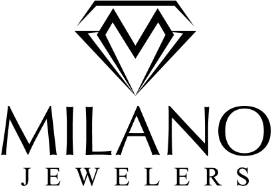Learn About Diamonds
The Four C's of Diamonds
Our Four C's of Diamondsguide can help you decide on the most important factors when shopping for a diamond.
Collapsible content
Carat
The Carat Weight.
The word carat derives from the word carob, a Mediterranean seed, which has an extremely consistent weight for measuring. Carat weight is a pretty simple measure. The greater the carat weight, the rarer, and more valuable the diamond becomes. Five metric carats weighs exactly 1 gram. One carat weighs exactly 1/5th of a Gram.
Some people want the largest diamond possible. If size is a priority, we at Milano Jewelers can help you choose the proper cut, color and clarity to fit your budget economically, and fit your jewelry beautifully. Many of our engagement rings can fit diamonds up to 5.00 carats, but each ring has different size constraints based on its size and the type of setting. Prong settings can be adjusted to fit virtually any size diamond, but diamonds set in halos and bezels have more limitations on size.
Cut
The Cut.
There are two ways to think of Cut. The term 'Cut' is often confused with the shape of the diamond such as Round, Marquise, Pear Shape, Oval, Emerald and other fancy cuts. After a rough diamond is mined, it is evaluated to determine its best possible cut, in order to maintain the maximum clarity, color, and carat weight.The finished shape of each diamond will in large part be dictated by the shape of the rough stone and the presence and position of any inclusions. These cut differences have minimal effect on value.
The other definition of Cut is the quality of the proportions, symmetry, and polish of the diamond. Your diamond's proportions make a vast difference on how brightly your diamond shines. Many experts consider Cut to be the most important C. An 'ideal cut' diamond falls within a narrow range of proportions that allows the maximum amount of light to return through the top of the diamond. This takes into consideration the depth percentage, table size, crown height and angle, girdle thickness and more. Lucky for you, and us, diamonds do not have to adhere to these uber strict cutting guidelines to be beautiful. All of the world's most famous diamonds that were cut before the advent of the 'ideal cut' in the early 1900's are considered beautiful by experts and casual observers the world over. Our diamond professionals will be happy to assist you in selecting the diamond cut that speaks to you.
Color
The Color.
Color is probably the second most important attribute of a diamond and has a heavy impact on the price of the stone. Diamonds come in the whole rainbow of colors but the most common range from colorless to yellow or light brown. The color scale is almost like an inverted bell curve. The standard scale runs from D to Z in color with the presence of color increasing as you move towards Z. The less color, the rarer and more expensive the diamond. After 'Z' on the color scale, diamonds fall into the Fancy color range. Here color is good. The more color the diamond exhibits the rarer and more expensive it becomes. Fancy color grades use terms like Light, Fancy Light, Fancy, Fancy Intense and Fancy Vivid. One of the world's most famous Fancy Colored diamonds is the Hope Diamond which resides in the Smithsonian Museum in Washington DC.
Clarity
The Clarity.
Diamonds are composed of mostly crystalized carbon. During the growth process, other elements become trapped inside, giving each diamond its own unique fingerprint. These inclusions help identify the clarity of your diamond. All diamonds are graded as viewed through a 10x magnification lens by experienced diamond graders. This makes clarity the least understood of the 4 C's because it's often not visible to the naked eye and yet in the higher grades it makes a huge impact on the value of the diamond. Because clarity characteristics are so small this is one area that allows you to save big money by choosing a diamond that grades a little lower on paper but still packs a big sparkle.
We'll be happy to sit with you and show you how the different factors affect the appearance and price of a diamond.
Diamond Buying Tips
Buying a diamond can be one of the most important purchases in your life. These tips may help make it easier when making this important purchase.
Diamond Weight & Size
Some people want to buy the biggest diamond possible. Is this always the right choice? We feel that it's always a matter of preference, but are some things to think about:
Clarity vs Cut
The larger the diamond, chances are the more inclusions it has, and because it's larger, these inclusions are typically more visible to the eye than on a smaller diamond. But most importantly, if the diamond cut isn't proportioned correctly, it won't return the maximum amount of light through the top of the diamond.
This illustrates that no matter how large the diamond, its cut and proportions determine how brilliant the diamond really is. Strong brilliance can compensate for slightly lower clarity. Prioritizing cut over clarity often yields a better price value in your purchase.
Diamond Color
The most common diamond colors range from colorless to yellowish-brown. Sometimes these colors can add warmth or depth to your diamond. Also, by mounting a non-colorless diamond in yellow gold can make the diamond appear colorless in some cases.
We are always happy to share our expertise about diamonds. Please let us know how we can help you make a confident decision in your diamond purchase.
More Diamond Education
- Schedule a Diamond Consultation with us
- Learn how to Care for your Diamonds
